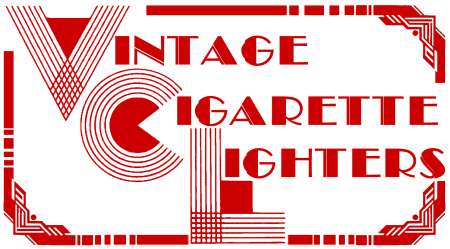|
Today, lighting a fire is not a problem. Lighters are ubiquitous, inexpensive, dependable, and available in myriad sizes, types, and styles. Everyone knows what a lighter is. This was not always the case, by any means. Here is a timeline in the development of lighters. Now, loosely speaking, lighters, a method of producing fire, were around in various forms long before this timeline starts; this timeline is an attempt to trace the roots of the modern cigarette / cigar / pipe lighter, so it doesn't start with the Cave Man, but it does include matches.
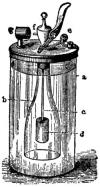 circa 1823: circa 1823:
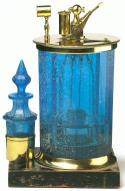 Johann Wolfgang Dobereiner discovers the catalytic process resulting in the invention of Dobereiner's Lamp which was in production until circa 1880. It is a catalyst lighter that produces hydrogen gas which is ignited using platinum as a catalyst. Through the years this process forms the basis for many, many lighters including some very familiar to collectors such as Lektrolite and New Method lighters. Since the Dobereriner lighters produced hydrogen gas, they could also unexpectedly explode. Johann Wolfgang Dobereiner discovers the catalytic process resulting in the invention of Dobereiner's Lamp which was in production until circa 1880. It is a catalyst lighter that produces hydrogen gas which is ignited using platinum as a catalyst. Through the years this process forms the basis for many, many lighters including some very familiar to collectors such as Lektrolite and New Method lighters. Since the Dobereriner lighters produced hydrogen gas, they could also unexpectedly explode.
circa 1826:
The friction match is invented by English chemist John Walker. This is the first truly portable, easily used, readily available source of "instant fire". It did have drawbacks as it was ignited by friction rubbing on any surface, occasionally would almost explode when lit, and could throw sparks off with the potential of lighting any surrounding combustible material.
circa 1836:
Hungarian chemistry student Janos Irinyi invents the "Noiseless Match". This is an improvement because the match lights more smoothly. It is still dangerous because, again, friction will ignite the match; its greatest convenience is also its greatest weakness and danger.
 circa 1844: circa 1844:
 The "Safety Match" is invented by Gustaf Erik Pasch of Sweden and improved by Johan Edvard Lundstrom. Johan and younger brother Carl Frans started a production facility for safety matches and by the mid-to-late 1850s it was a thriving industry producing millions of boxes of safety matches - essentially the same safety match we use today that you have seen in matchbooks (which were introduced circa 1890) and the small match boxes. The safety match separates the chemicals so the match must typically be struck against a special surface to ignite. These safety matches got a lot of notice at the 1855 World Exhibition in Paris. The "Safety Match" is invented by Gustaf Erik Pasch of Sweden and improved by Johan Edvard Lundstrom. Johan and younger brother Carl Frans started a production facility for safety matches and by the mid-to-late 1850s it was a thriving industry producing millions of boxes of safety matches - essentially the same safety match we use today that you have seen in matchbooks (which were introduced circa 1890) and the small match boxes. The safety match separates the chemicals so the match must typically be struck against a special surface to ignite. These safety matches got a lot of notice at the 1855 World Exhibition in Paris.
circa 1880:
The first 'fusee' lighter is introduced. A fusee (comes from 'fuse' as used on early cannons) is a cord impregnated with chemicals to assist it in burning - not quickly where a flame would be produced, but slowly and without an open flame. In the early versions a gear system was used to turn a fire steel to produce sparks and ignite the fusee. Later versions used the fusee as a wick immersed in gasoline in a tank - the beginnings of the more modern flint and petrol lighter. The fusee was extinguished by covering it with a cap, denying the oxygen necessary to burn.
circa 1889:
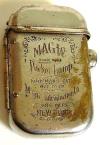 The Magic Pocket Lamp is introduced. It has a fusee and uses percussion caps (think toy cap pistols) on a cardboard disc to ignite a gasoline soaked fusee (a wick, if you please). This is another step closer to the "modern" pocket lighter as we know it. This was likely a very noisy lighter, so anyone would know when you were lighting up! The Magic Pocket Lamp is introduced. It has a fusee and uses percussion caps (think toy cap pistols) on a cardboard disc to ignite a gasoline soaked fusee (a wick, if you please). This is another step closer to the "modern" pocket lighter as we know it. This was likely a very noisy lighter, so anyone would know when you were lighting up!
circa 1898:
 The "Strike Anywhere Match", a greatly improved friction match, is patented by French chemists Savene and Cahen. With somewhat altered chemical substances and a separation of them, they developed a match that wasn't as poisonous or as volatile as a new safety match that could be struck anywhere. This is essentially the same match in use today in the boxes of wooden matches with two-colored heads (separation of chemicals). This type of match was introduced in England circa 1899 and the USA circa 1901. The "Strike Anywhere Match", a greatly improved friction match, is patented by French chemists Savene and Cahen. With somewhat altered chemical substances and a separation of them, they developed a match that wasn't as poisonous or as volatile as a new safety match that could be struck anywhere. This is essentially the same match in use today in the boxes of wooden matches with two-colored heads (separation of chemicals). This type of match was introduced in England circa 1899 and the USA circa 1901.
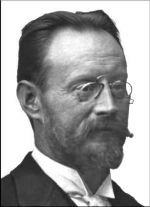 1903: 1903:
Carl Auer von Welsbach, an Austrian chemist, discovered that ferro cerium (an amalgam of iron and cerium) produces powerful sparks when scratched. The alloy became known as Auer metal / Auermetal and was adopted for use as the 'flint' in cigarette lighters - the same flints we still use and that made possible the modern lighter. In 1907 the first factory to make Auermetal was opened and the rest is history!
And then...
Over the ensuing years many styles and mechanisms were developed, but all used the same basic method and materials - flint and petrol. There was a flint and striking wheel to produce a spark; a wick soaked with fuel to carry the flame, and a fuel storage tank, most typically packed with sawdust (very infrequent) or fiber (e.g. wool, cotton) and this was a lighter with the variance being in the casement and striking mechanism. It should be noted that what we use in lighters now, known as lighter fluid, was historically very different. Early lighters used gasoline, kerosene, and naphtha.
 Fusee cord lighters using just a flint tube, striker wheel and holder for the cord were in Fusee cord lighters using just a flint tube, striker wheel and holder for the cord were in 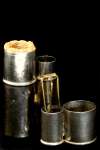 widespread use virtually from the time of the invention of the flint (and, as noted above, in other forms prior to that) and continued to be manufactured through the 1940s. This was just about the simplest possible configuration for a lighter. widespread use virtually from the time of the invention of the flint (and, as noted above, in other forms prior to that) and continued to be manufactured through the 1940s. This was just about the simplest possible configuration for a lighter.
Catalytic lighters were in widespread but sporadic use from the early 1900s through the 1950s but safety problems and the lethal nature of the fuel (methanol) meant they never enjoyed the widespread and ongoing use that conventional flint and petrol lighters did.
1926:
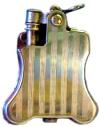 The Ronson 'Banjo' is the first truly automatic lighter ('Banjo' is not the name - it is a nickname applied to the lighter because of its style). "Press it's lit - release it's out." Prior to this the closest lighters for to 'automatic' was the push button that released a spring arm mechanism causing the flint wheel to move against the flint and produce sparks and light a flame. The flame had to be manually extinguished and the arm (or cover, in many lighters) manually returned to its starting position before it could be activated again; 'semi-automatic' is the real term for such lighters. The Ronson 'Banjo' is the first truly automatic lighter ('Banjo' is not the name - it is a nickname applied to the lighter because of its style). "Press it's lit - release it's out." Prior to this the closest lighters for to 'automatic' was the push button that released a spring arm mechanism causing the flint wheel to move against the flint and produce sparks and light a flame. The flame had to be manually extinguished and the arm (or cover, in many lighters) manually returned to its starting position before it could be activated again; 'semi-automatic' is the real term for such lighters.
Late 1920s:
At this point in time there were four basic types of lighters: the manual striking type (lift arm lighters, wheel lighters, and Zippo types - though this is before Zippo's time), the semi-automatic type (push button lighters), the automatic lighters (e.g. Ronson 'Banjo'), and striker lighters (which used a pull out wand to strike against a flint strip - basically a 'permanent match'.
The semi-automatic lighter began showing up in the very beginning with such lighters as the Hahway, Nassau, and others. Lift arm type lighters also got springs and release mechanisms making them semi-automatic in the early 1920s.
Most Prominent Types of Lighters Available Late 1920s
|
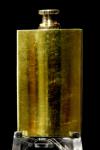 |
 |

This lighter is illustrative of fusee lighters, but this make/model was not available until the later 1930s |
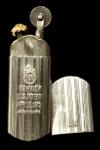 |
STRIKER
Ronson Paragon |
FUSEE
Bowers Army & Navy |
WHEEL
Hahway |
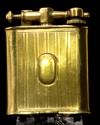 |
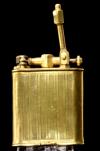 |
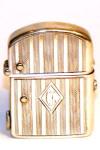 |
 |
LIFT ARM MANUAL
Park Sherman |
SEMI-AUTOMATIC
Nassau Push Button |
 |
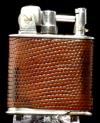 |
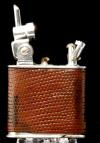 |
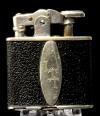 |
WHEEL
Last Longer |
SEMI-AUTOMATIC
Lancel 'Automatic' |
AUTOMATIC
Ronson Standard De-Light |
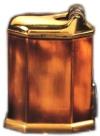 1947: 1947:
The first gas fueled lighter, the Gentry - a table lighter, is introduced by the Quercia family owned Flaminaire Company and is shortly followed by a pocket model called the Crillion. An identical lighter was marketed under license in the USA by the Parker Pen Company - the Parker Flaminaire in the 1950s. The early butane lighters all used  proprietary single use gas tanks. When the tank was empty, you bought another one - a good revenue stream for the manufacturers. Later this evolved to a system of refillable tanks that used proprietary cylinders to fill them - you had to buy the right gas cylinder for your lighter. A little further on butane gas could be bought from third party manufacturers - who often included adapters so you could refill any of several brands of lighters. Eventually almost all butane lighters used standardized filler mechanisms. In some cases, it is possible to still get the old lighters and work on the tanks to make them refillable and end up with a working lighter. proprietary single use gas tanks. When the tank was empty, you bought another one - a good revenue stream for the manufacturers. Later this evolved to a system of refillable tanks that used proprietary cylinders to fill them - you had to buy the right gas cylinder for your lighter. A little further on butane gas could be bought from third party manufacturers - who often included adapters so you could refill any of several brands of lighters. Eventually almost all butane lighters used standardized filler mechanisms. In some cases, it is possible to still get the old lighters and work on the tanks to make them refillable and end up with a working lighter.
1961:
  The French Samec Company introduces the first disposable butane lighter - the Cricket. The disposable lighter was to have almost as much a transforming effect on the lighter industry as the flint because it ushered in a new age of very cheap, disposable lighters and effectively put most of the makers of durable lighters out of business over a period of time. Cricket was acquired by Gillette (safety razors / blades) in 1970 and introduced in the USA in 1972. The French Samec Company introduces the first disposable butane lighter - the Cricket. The disposable lighter was to have almost as much a transforming effect on the lighter industry as the flint because it ushered in a new age of very cheap, disposable lighters and effectively put most of the makers of durable lighters out of business over a period of time. Cricket was acquired by Gillette (safety razors / blades) in 1970 and introduced in the USA in 1972.
1962:
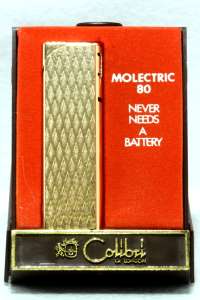 The first patent application for a piezoelectric lighter is submitted by Sapphire-Molectric - a subsidiary of Colibri - and designed by Hans Lowenthal and Martin Paul Levy. The second patent was submitted in Japan in 1964 by Mansei Koyo. The first piezoelectric to hit the market was the Maruman Business Table Lighter in 1966. The Colibri Moletric 80 was the earliest pocket size piezoelectric lighter - the Molectric 88, which came out 2 years later, is also pictured. This ushers in the piezoelectric ignition that replaces flint and a host of The first patent application for a piezoelectric lighter is submitted by Sapphire-Molectric - a subsidiary of Colibri - and designed by Hans Lowenthal and Martin Paul Levy. The second patent was submitted in Japan in 1964 by Mansei Koyo. The first piezoelectric to hit the market was the Maruman Business Table Lighter in 1966. The Colibri Moletric 80 was the earliest pocket size piezoelectric lighter - the Molectric 88, which came out 2 years later, is also pictured. This ushers in the piezoelectric ignition that replaces flint and a host of 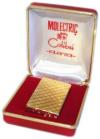 piezoelectric lighters in the mid-1960s through the 1970s. Still very much in use, they are no longer as common as they once were. The name 'piezo' derives from the Greek 'piezen' meaning 'to press'. A piezoelectric device consists of a small, spring-loaded hammer which, when a button is pressed, hits a crystal of PZT or quartz crystal. Quartz is piezoelectric, which means that it creates a voltage when deformed. This sudden forceful deformation produces a high voltage and subsequent electrical discharge, which ignites the gas. The discovery of and earliest research on the phenomenon of piezoelectricity was in the mid-1800s. Many synthetic materials have also been produced to generate the piezoelectric effect. piezoelectric lighters in the mid-1960s through the 1970s. Still very much in use, they are no longer as common as they once were. The name 'piezo' derives from the Greek 'piezen' meaning 'to press'. A piezoelectric device consists of a small, spring-loaded hammer which, when a button is pressed, hits a crystal of PZT or quartz crystal. Quartz is piezoelectric, which means that it creates a voltage when deformed. This sudden forceful deformation produces a high voltage and subsequent electrical discharge, which ignites the gas. The discovery of and earliest research on the phenomenon of piezoelectricity was in the mid-1800s. Many synthetic materials have also been produced to generate the piezoelectric effect.
Electric Lighters
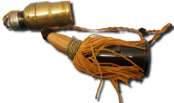 A number of electric lighters and battery powered lighters have come and gone over the years. The biggest point is, they've gone and didn't stay long when they were here. Examples of electric and battery lighters are: A number of electric lighters and battery powered lighters have come and gone over the years. The biggest point is, they've gone and didn't stay long when they were here. Examples of electric and battery lighters are:
The Tassel-Liter (circa 1935) which was made in Chicago, IL and was designed with a socket that screwed into a light bulb fixture. In turn the light bulb was screwed into the socket so you didn't lose a light fixture! Wires from the socket then went to the lighter element, which has a tassel over it. The lighter was operational whether the light bulb was turned on or off. 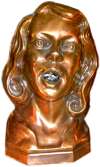 A button was pushed to bring current to the heating element in the tassel-Liter so a cigar or cigarette could be lit. A button was pushed to bring current to the heating element in the tassel-Liter so a cigar or cigarette could be lit.
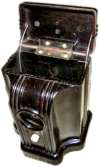 The girl's head lighter (circa 1936) was typically found in tobacco shops - a bit suggestive for places with mixed company - and a cigar or cigarette was lit by using the heating element in the girl's mouth. Could Bill Clinton have been exposed to one of these as a youngster? The girl's head lighter (circa 1936) was typically found in tobacco shops - a bit suggestive for places with mixed company - and a cigar or cigarette was lit by using the heating element in the girl's mouth. Could Bill Clinton have been exposed to one of these as a youngster?
A table model electrical lighter by the Tarrson Company of Chicago has a cigarette box built into it so one could get a cigarette out of the box, push the button on the lighter, and get a light. All of these units used a heating element that would get hot enough to ignite a cigar or cigarette.
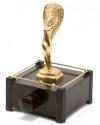 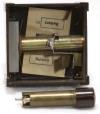 Battery powered lighters were used early on as table lighters - touch tips was the most common name for them. A Parker-Beacon Silent Flame lighter (mid-1930s) is shown. This particular lighter takes two D-Size batteries in the base. The wand is removed and laid on one of the wires and the tip is touched against the statuette. This completes and electrical circuit with the batteries and causes a small coil in the tip of the wand to heat up enough to ignite a cigarette - exactly the same as cigarette lighters which used to be in cars. Battery powered lighters were used early on as table lighters - touch tips was the most common name for them. A Parker-Beacon Silent Flame lighter (mid-1930s) is shown. This particular lighter takes two D-Size batteries in the base. The wand is removed and laid on one of the wires and the tip is touched against the statuette. This completes and electrical circuit with the batteries and causes a small coil in the tip of the wand to heat up enough to ignite a cigarette - exactly the same as cigarette lighters which used to be in cars.
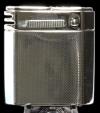 The German Fumalux was the first practical and commercially successful battery operated pocket lighter and it came out in the 1950s. The German Fumalux was the first practical and commercially successful battery operated pocket lighter and it came out in the 1950s.  It used a 2 volt battery for the power source and a heating coil to generate the heat to light the lighter fluid in a wick - rather than lighting the cigarette directly with the coil. This scheme required less power and allowed the battery to function long enough to be somewhat practical. These were sold worldwide under a number of brand names including Magna-Lux which was frequently seen in the USA. These lighters also included a light bulb so they had a flashlight function, as well. The fact that there weren't many models and that they are rarely seen is mute testimony to the fact that they just didn't work out. It used a 2 volt battery for the power source and a heating coil to generate the heat to light the lighter fluid in a wick - rather than lighting the cigarette directly with the coil. This scheme required less power and allowed the battery to function long enough to be somewhat practical. These were sold worldwide under a number of brand names including Magna-Lux which was frequently seen in the USA. These lighters also included a light bulb so they had a flashlight function, as well. The fact that there weren't many models and that they are rarely seen is mute testimony to the fact that they just didn't work out.
 In the mid-1960s General Electric tried out a rechargeable cigarette lighter. It was large by pocket lighter standards. Looking back and seeing only a single model of it, few advertisements for it, and no competitors provides ample evidence that it just didn't work out, either. In the mid-1960s General Electric tried out a rechargeable cigarette lighter. It was large by pocket lighter standards. Looking back and seeing only a single model of it, few advertisements for it, and no competitors provides ample evidence that it just didn't work out, either.
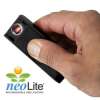 As the photo shows, electric lighters are still with us - though still not very prominent. This is a model that plugs into a computer USB port to obtain power and currently available. As the photo shows, electric lighters are still with us - though still not very prominent. This is a model that plugs into a computer USB port to obtain power and currently available.
In conclusion...
Lighters developed along several lines and the basics have not changed.
 We can still find fusee lighters on eBay, though they haven't been in common use since the end of the 1940s. We can still find fusee lighters on eBay, though they haven't been in common use since the end of the 1940s.
 Old and early striker lighters are sought by collectors, but modern versions are widely available to this day. Old and early striker lighters are sought by collectors, but modern versions are widely available to this day.
Flint and petrol lighters, dating from about 1908, are still made and easily available today.
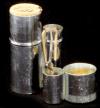 Catalytic lighters such as the now-long-discontinued New Method and Lektrolite are still available on eBay and, new ones, though difficult to find, are available as hand warmers. The catalytic lighters have had several lives: they were widely used in the very early 1900s, fell out of favor, had a resurgence in the 1930s, fell out of favor again, and had what was most likely their 'last gasp' in the 1950s. Catalytic lighters such as the now-long-discontinued New Method and Lektrolite are still available on eBay and, new ones, though difficult to find, are available as hand warmers. The catalytic lighters have had several lives: they were widely used in the very early 1900s, fell out of favor, had a resurgence in the 1930s, fell out of favor again, and had what was most likely their 'last gasp' in the 1950s.
There are books and more information available on the development and history of lighters if you want to know more. One of the best books at presenting the whole story is The Legend of the Lighter by Ad van Wert - out of print, but not too difficult to find - it is a beautiful, hard cover, coffee-table size book with wonderful pictures of lighters from the Dutch Lighter Museum Foundation's collection.
Photo Sources: Dobereiner's Lamp - Wikipedia & "The Legend of the Lighter"; safety matches(2) - eBay; Magic Pocket Lamp - thelampworks.com; strike anywhere matches - Frank Dutton; Auer von Welsbach - Wikipedia; Ronson Banjo - eBay; Flaminaire Gentry - abbeville.com; Flaminaire Crillion - liveauctioneers.com; original Cricket - cricketlighters.com; 1975 Cricket - eBay; Colibri Moletric 88 - photos1.blogger.com; Bowers Army & Navy, Ray-O-Lite catalytic, Park Sherman Lift Arm, Hahway Wheel, Last Longer, Ronson Standard De-Light, Magna-Lux, Parker Touch Tip, Wind King, New Method, Lancel Automatic, 'Match' striker - Frank Dutton; Nassau lighter - Larry Tolkin; neo-Lite - Amazon.com; Tassel-Liter, Tarrson Electric, open mouth girl - eBay
|
